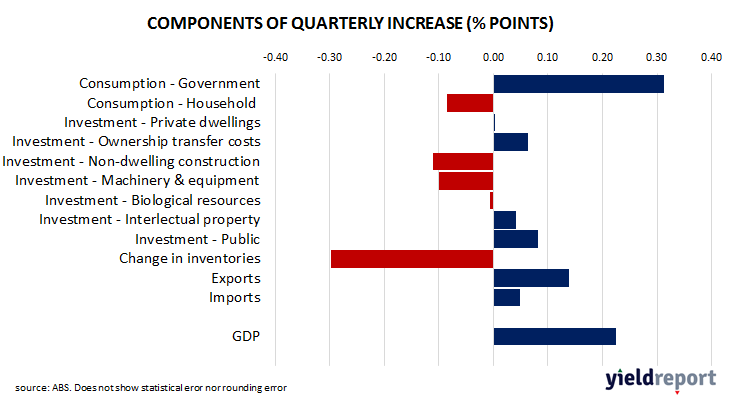Summary: Australia’s GDP up 0.2% in June quarter, in line with expectations; up 1.0% over year; Westpac: largest quarterly decline in consumer spending since GFC excluding COVID period; ACGB yields fall moderately; rate-cut expectations firm, February rate cut again priced in ; ANZ: weakness in private sector more than offset by strength in public sector; government spending, inventories major influences in quarter.
Since the “recession we had to have” as the recession of 1990/91 became known, Australia’s GDP growth has been consistently positive, with only the odd negative quarter here and there. However, Australia’s first recession in nearly thirty years was inevitable in 2020 once governments introduced restrictions which shut businesses and limited people’s movements for an extended period of time. Growth rates have been positive since then, although the September 2021 quarter proved to be the exception after restrictions were reintroduced in eastern states.
The latest GDP figures have now been released by the ABS and they indicate GDP rose by 0.2% in the June quarter. The result was in line with expectations but up slightly from the March quarter’s 0.2% after it was revised down from 0.3%. On an annual basis, GDP expanded by 1.0%, down from 1.3% in the previous quarter after revisions.
“The underlying mix provided the big surprise, with consumer spending falling 0.2%, the largest quarterly decline since the GFC excluding the COVID period,” said Westpac senior economist Pat Bustamante. “This is particularly weak given the backdrop of strong population growth, up another 0.6% in Q2, the second strongest quarterly jump in the population on record.”
Commonwealth Government bond yields fell moderately on the day, lagging the downward movements of US Treasury yields overnight. By the close of business, the 3-year ACGB yield had lost 3bps to 3.56%, the 10-year yield had shed 5bps to 3.96% while the 20-year yield finished 3bps lower at 4.38%.
Expectations regarding rate cuts in the next twelve months firmed, with a February 2025 rate cut again fully priced in. Cash futures contracts implied an average of 4.335% in September, 4.32% in October and 4.265% in November. February 2025 contracts implied 4.05% while August 2025 contracts implied 3.48%, 86bps less than the current cash rate.
“Pronounced weakness in the private sector, which subtracted 0.2 percentage points from Q2 GDP growth, was more than offset by strength in the public sector, which added 0.4 percentage points,” said ANZ senior economist Catherine Birch.
Government consumption expenditures increased by $1.9 billion, contributing 0.31 percentage points to the quarter’s result, while a $1.8 billion change in inventories contributed -0.30 percentage points. Households consumption subtracted 0.09 percentage points after a $0.5.billion fall.



